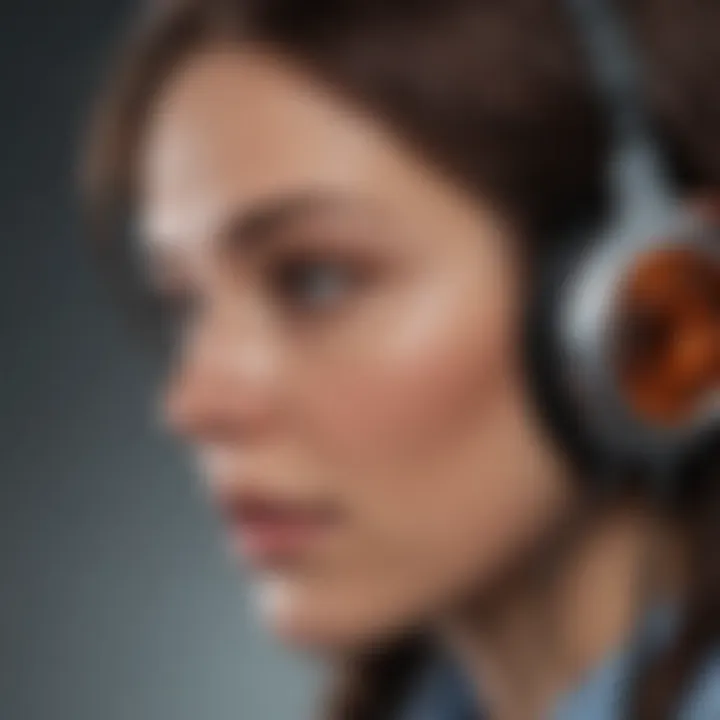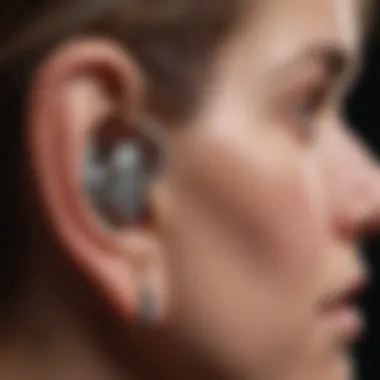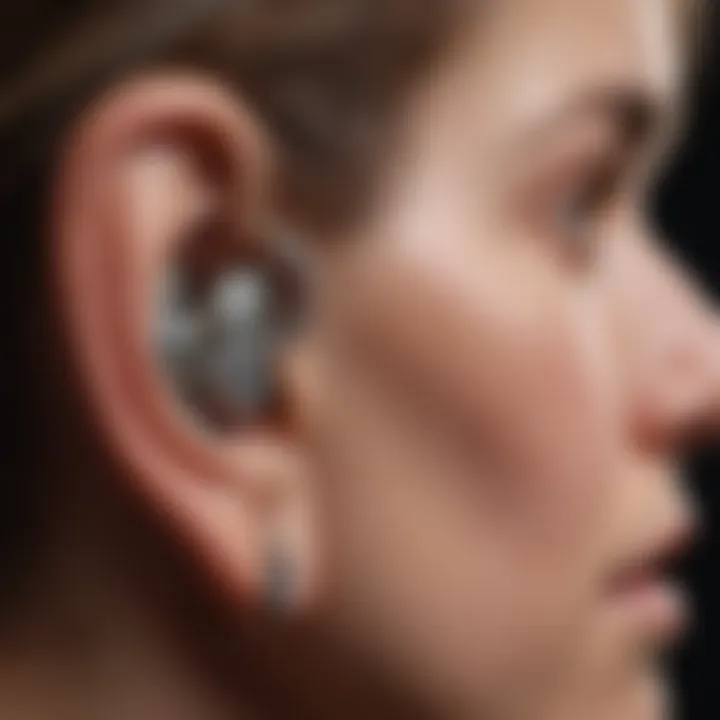Understanding the Frequency of Hearing


Intro
Hearing is a complex phenomenon involving the detection and interpretation of sound waves. The concept of frequency plays a crucial role in understanding how we perceive these sounds. This section serves as an introduction to the intricacies of hearing frequency, the factors influencing auditory perception, and the implications they have on communication and daily life.
The frequency of sound, measured in Hertz (Hz), determines the pitch of what we hear. Humans generally hear sounds ranging from about 20 Hz to 20,000 Hz, but individual capabilities can vary significantly. Age, noise exposure, and physical health shape one’s auditory range. Gaining insights into these variations not only heightens our understanding of human hearing but also underscores the importance of related fields, such as audiology and health sciences.
With advancements in technology, we continue to see developments in hearing aids and sound systems which aim to enhance hearing abilities. This leads us to a consideration of how frequency influences our auditory experiences and is critical in research and practice. As we navigate through this article, we will cover the relevant methodologies used in hearing research, potential future directions for exploration, and the integration of technological innovations in hearing.
By fostering a comprehensive understanding of hearing frequency, we can appreciate its significance in both scientific investigation and everyday applications. Let’s dig deeper into the methodologies employed in research surrounding hearing frequency.
Understanding Hearing Frequency
The concept of hearing frequency encompasses the fundamental principles of how we perceive sound. Understanding this topic is crucial for multiple fields, including audiology, acoustics, and communication studies. By analyzing hearing frequency, we uncover the intricate relationship between sound waves and human perception. This understanding has direct implications for improving communication, enhancing technology like hearing aids, and informing health-related matters.
Moreover, comprehending hearing frequency also aids in recognizing the variations in auditory capabilities among individuals. The factors influencing these variations, such as age, genetics, and environmental conditions, further solidify the need for research in this domain. It is vital to appreciate why some individuals can hear certain frequencies while others may struggle. This knowledge not only informs academic discourse but also enriches professional practices in healthcare and education.
The Basics of Sound Waves
Sound waves are vibrations that travel through mediums, such as air, water, or solid materials. These waves comprise pressure variations, which are typically measured in Hertz (Hz). The frequency of a sound wave refers to the number of cycles it completes in a second, determining how high or low a sound appears to the human ear.
In general terms, sound waves can be classified as:
- Longitudinal waves: where particles of the medium move parallel to the direction of the wave.
- Transverse waves: where particles of the medium move perpendicular to the wave direction.
Human perception of sound is highly sensitive and can differentiate between a vast range of frequencies, from the lowest bass notes to the piercing treble sounds. The study of these frequencies provides insights into acoustic design and the effects of sound in various environments.
Defining Frequency in Acoustics
In acoustics, frequency plays a pivotal role in defining sound properties. Frequencies typically range from 20 Hz to 20,000 Hz for most humans, although this range can decrease with age or due to hearing impairments. Within this range, we can identify several key points:
- Infrasonic waves: Below 20 Hz, these sounds are generally inaudible to humans but can affect us physically.
- Audible range: From 20 Hz to 20,000 Hz is where most communication and musical sounds reside.
- Ultrasonic waves: Above 20,000 Hz, these sounds are also inaudible to the human ear but are utilized in technology, like ultrasound imaging.
Understanding the definition and range of frequency in acoustics allows professionals to tailor audio experiences, whether in music production, sound engineering, or in developing auditory devices.
"The human ear is capable of detecting frequencies within a remarkable range, but individual differences necessitate a focused approach to auditory health and technology.
Through this exploration, listeners, engineers, and researchers gain valuable insights, thereby enhancing their comprehension of hearing frequency and its broader implications in everyday life. The importance of hearing frequency extends beyond basic information; it serves as a cornerstone for developing advanced auditory technologies that improve the lives of many.
For further understanding, resources such as Wikipedia or Britannica provide comprehensive information on the subject.
Human Frequency Range
The human frequency range is fundamental to understanding how we perceive sound. It encompasses the limits of sound waves that a typical human ear can detect. Understanding this range is crucial for various fields, including audiology, psychology, and sound engineering.
By assessing human frequency capabilities, we can shed light on hearing health and the kinds of sounds individuals can experience. This knowledge also helps in the design of hearing aids and sound systems, ensuring they cater effectively to users' needs.
In the context of sound perception, the human frequency range typically lies between 20 Hz to about 20 kHz. This range is significant because it dictates what sounds can be heard by most people, influencing communication and interaction with the environment.
Normal Hearing Range
Normal hearing range refers specifically to the frequencies that the average individual can hear without any assistance. This range is typically between 20 Hz and 20 kHz, although it can vary slightly among individuals. Most adults tend to hear frequencies between 1 kHz to 4 kHz with the greatest sensitivity, a range where many important speech sounds reside.
The ability to hear within this range is essential for effective communication. Understanding this helps audiologists develop better hearing assessments and treatments.
Factors Affecting Hearing Range
Hearing capabilities can be influenced by several factors:
Age
Age is a significant factor that can alter an individual's hearing range. As people grow older, they may experience presbycusis, a type of age-related hearing loss. This condition often leads to a reduction in the ability to hear higher frequencies, specifically above 8 kHz. Older adults may find it increasingly challenging to hear subtle sounds, making it a relevant consideration in this article. Understanding the impact of age on hearing can inform strategies for intervention and education, promoting better auditory health in aging populations.


Genetics
Genetics also play a critical role in determining one's hearing range. Some individuals may inherit a predisposition to hearing loss or heightened sensitivity to certain frequencies. Notably, genetic variations can affect how well one can perceive sounds in different environments. This strong link between genetics and hearing capabilities is an important consideration when discussing hearing impairment. Identifying genetic markers can help in predicting potential hearing issues, allowing for earlier and more effective interventions.
Environmental Influence
Environmental factors contribute significantly to hearing capabilities. Exposure to loud noises, whether from machinery or social environments, can lead to temporary or permanent hearing loss. Chronic exposure to such conditions affects the auditory system, leading to a decrease in sensitivity across various frequencies. Moreover, environments with excessive background noise complicate the ability to hear effectively within the normal range. Understanding these influences can aid in developing guidelines for noise exposure and highlight the need for protective measures in various settings.
Overall, factors such as age, genetics, and environmental influences collectively shape the hearing capabilities of individuals. Recognizing these influences is vital for developing effective hearing tests and interventions.
The Physiology of Hearing
The physiology of hearing is a crucial component of understanding how humans perceive sound. This section explores the intricate anatomy and functions of the auditory system. It underlines the processes that allow us to interpret various sound frequencies. A strong grasp of these physiological elements not only enhances knowledge within audiology but also informs practices related to health science, communication, and technology.
Anatomy of the Ear
The ear consists of three primary sections: the outer ear, the middle ear, and the inner ear. Each section has specialized functions that work together to facilitate hearing.
- Outer Ear: This includes the visible part, known as the pinna, and the ear canal. The pinna gathers sound waves and channels them into the ear canal.
- Middle Ear: Comprised of the tympanic membrane (eardrum) and three small bones termed ossicles, this section amplifies the sound waves. The ossicles include the malleus, incus, and stapes. They change the sound waves from the air into vibrations that then travel to the inner ear.
- Inner Ear: The cochlea is a spiral-shaped structure filled with fluid. It contains hair cells that move in response to fluid vibrations. These movements convert mechanical vibrations into electrical signals, which the auditory nerve then transmits to the brain.
Understanding this anatomy is vital because each part plays an essential role in how sound is detected and processed. Any impairment in these areas can lead to various types of hearing loss, affecting quality of life.
How the Auditory System Processes Sound
The auditory system's processing of sound involves several steps that convert sound waves into perceivable information.
- Sound Wave Entry: Sound waves enter through the outer ear and travel down the ear canal to vibrate the tympanic membrane.
- Vibration Transmission: The vibrations created by the eardrum move the ossicles, amplifying the sound. The stapes connects to the oval window of the cochlea, a vital entry point into the inner ear.
- Fluid Movement: The movement of the stapes creates fluid waves within the cochlea, leading to the activation of hair cells in the basilar membrane.
- Signal Conversion: Hair cells convert these mechanical movements into electrical signals. This conversion is crucial for translating different frequencies and intensities of sound.
- Nerve Impulse Transmission: The auditory nerve carries these electrical signals to the auditory cortex in the brain, where sound is interpreted based on various factors, including frequency and amplitude.
This whole process highlights how nuanced and sophisticated our hearing system is. By understanding these functions, researchers can better address hearing impairments and develop technological aids that enhance auditory experiences.
"The auditory system is not only a physical mechanism but a complex process that involves interpretation, memory, and context."
By diving deep into the physiology of hearing, we achieve not only a scientific understanding but also insights into the challenges faced by individuals with hearing impairments. This knowledge is foundational for further research and development in enhancing audibility and communication, thus improving the lives of many.
Hearing Loss and Frequency
Understanding the relationship between hearing loss and frequency is crucial for numerous reasons. First, it helps us comprehend how hearing loss manifests in various contexts and its implications on daily life. The nature of hearing loss can directly affect the frequencies individuals are able to perceive. Different types of hearing loss impact auditory frequency response, leading to unique challenges in communication, safety, and quality of life.
In this section, we will explore the different types of hearing loss, how they relate to frequency perception, and the importance of recognizing these distinctions for effective diagnosis and treatment.
Types of Hearing Loss
Conductive Hearing Loss
Conductive hearing loss occurs when sound waves are obstructed in the outer or middle ear. This type of hearing loss can often be temporary and is frequently the result of ear infections, fluid buildup, or blockages. The key characteristic of conductive hearing loss is its impact on the passage of sound, making it more difficult for individuals to hear softer sounds. In the context of frequency analysis, this type of hearing loss typically affects lower frequencies more significantly, making it a relevant focus for this article.
The unique feature of conductive hearing loss lies in its often reversible nature. Medical intervention such as surgery or medical treatment may restore hearing to normal or near-normal levels. This aspect is advantageous in discussions about hearing loss, as it opens avenues for recovery and improvement, which is quite promising for affected individuals.
Sensorineural Hearing Loss
Sensorineural hearing loss is caused by damage to the inner ear or the neural pathways that connect the ear to the brain. This condition affects the ability to hear certain frequencies and typically results in a permanent loss of hearing. A key characteristic of sensorineural hearing loss is its impact on higher frequencies, which can pose challenges in understanding speech and complex sounds. This type of hearing loss is often seen as a significant area of focus for audiologists and researchers.
The unique feature of sensorineural hearing loss is its complexity. Unlike conductive hearing loss, it is not usually treatable with medical interventions. Assistive devices like hearing aids become essential in managing this type of hearing loss. Recognizing this characteristic helps frame discussions about hearing aids and the need for tailored solutions.
Mixed Hearing Loss
Mixed hearing loss is a combination of both conductive and sensorineural hearing loss. It represents a unique challenge because it involves multiple factors that can affect various frequencies in distinct ways. The key characteristic of mixed hearing loss is that it can range widely in severity and type, depending on the individual's hearing functions.
A distinct feature of mixed hearing loss is its dual nature, where treatment may need to address both conductive and sensorineural components. This complexity shows the importance of detailed hearing assessments to develop effective management strategies. Understanding mixed hearing loss contributes essential insights to the discussion of frequency-specific diagnosis and treatment plans.
Frequency-Specific Hearing Loss
Frequency-specific hearing loss refers to the inability to perceive certain frequencies due to various forms of hearing loss. Understanding this condition is crucial in developing tailored treatment approaches. This selective loss can significantly hinder communication capabilities and can impact the social and psychological well-being of individuals. Attention to frequency-specific issues can enhance rehabilitation strategies, ensuring that interventions focus on the frequencies that matter most to each individual's specific needs.


Overall, the study of hearing loss and its relation to frequency is vital. It informs not only medical and technological developments but also guides future research in auditory health. Recognizing and addressing these different types of hearing loss can lead to better outcomes for individuals experiencing auditory challenges.
Psychological Aspects of Hearing Frequencies
The psychological dimensions of hearing frequencies play a vital role in understanding how sound perception influences human experiences. This segment brings to light the intricate connection between auditory perception and mental processes. Understanding this connection aids in comprehending how sound affects emotions, behaviors, and social interactions.
Perception of Sound and Frequency
The perception of sound and frequency relies on various psychological mechanisms that shape how individuals interpret auditory stimuli. This process involves not only physiological components but also cognitive and emotional responses. When sound waves enter the ear, they undergo mechanical transformations into electrical signals that the brain interprets. However, beyond the physical reception of sound, an individual's prior knowledge, cultural background, and emotional state are crucial.
- Prior Experience: Familiarity with certain frequencies can affect how one perceives them. For example, a person raised in a musically enriched environment might identify notes more distinctly than someone without that exposure.
- Cultural Influence: Different cultures perceive and value various sounds differently. What may be a pleasant frequency in one culture could be perceived as noise in another.
- Emotional Response: Certain frequencies can evoke emotional responses. Low frequencies may induce a sense of calm, while high frequencies can create anxiety. The way individuals react emotionally to different sounds can significantly affect their experiences in social or solitary contexts.
Impacts on Communication
Sound frequencies are essential in the communication process, influencing how messages are conveyed and interpreted. The subtleties of intonation, pitch, and volume not only convey information but also emotion and intent. Misinterpretation can result from the nuances in frequency modulation, highlighting the importance of understanding these aspects.
- Clarity and Distortion: High-frequency sounds are generally clearer and carry better than low frequencies. However, when sound environments become overly noisy, clarity diminishes. This distortion can lead to confusion or miscommunication.
- Social Interaction: Communication is not just verbal; non-verbal cues include tone and pitch. For instance, higher pitched voices may be associated with excitement or enthusiasm, whereas lower pitches might suggest authority or calmness. Small changes in frequency can alter meanings drastically.
- Barrage of Frequencies: In environments with competing sound frequencies, individuals may struggle to focus on a primary conversation. This multi-frequency backdrop challenges effective listening and can lead to misunderstandings in social contexts.
Important Note: Understanding the psychological aspects of hearing frequencies can not only improve interpersonal communication but also enhance overall social well-being.
Technological Advancements in Hearing Aids
Technological advancements in hearing aids mark a significant evolution in the domain of audiology. These developments not only improve sound quality but also enhance the overall user experience for individuals with hearing impairments. As hearing aids become more sophisticated, they offer a range of functionalities designed to meet diverse auditory needs. Key considerations include adaptability to different sound environments, user-friendliness, and connectivity to modern devices.
Modern hearing aids are equipped with advanced signal processing algorithms that help distinguish between various sounds. This feature is crucial for improving speech clarity in noisy environments. Additionally, digital signal processing allows for fine-tuning of sound frequencies. This ensures that wearers can perceive sounds at different frequencies more accurately, matching their individual hearing profiles.
Another important aspect is the miniaturization of technology. Hearing aids have become smaller, lighter, and often more discreet. This development helps in reducing the stigma associated with wearing such devices. Some models are virtually invisible when worn. These enhancements do not compromise on performance, as they often include advanced features like sound filtering, feedback cancellation, and dynamic range compression.
“As the technology advances, hearing aids are becoming an integral part of daily life for many individuals, seamlessly blending functionality with user comfort.”
Despite the benefits, considerations such as the need for regular maintenance, battery life, and the cost of advanced features remain significant challenges. Users are often required to keep their devices updated to enjoy the latest enhancements and performance improvements. Furthermore, the user’s understanding of technology plays a role in their ability to utilize the full potential of modern hearing aids.
In summary, technological advancements in hearing aids are essential for addressing the complexities of hearing loss. As products continue to evolve, they promise greater accessibility, functionality, and a significant improvement in the quality of life for those who rely on them.
Evolution of Hearing Aid Technology
The evolution of hearing aid technology can be traced back to basic acoustic devices. Initially, these devices amplifies all sounds without discrimination, often leading to discomfort for the user due to background noise. With the introduction of electrical hearing aids in the early 20th century, these devices began to transform auditory experiences.
The shift towards digital technology marked a turning point, allowing for automated adjustments based on the surrounding environment. Early digital aids focused on volume control. However, contemporary models now allow for customized sound profiles suited to individual listening preferences. This is largely thanks to miniaturized components and enhanced computing power.
A significant aspect of this evolution includes the integration of smartphone technology. Many current hearing aids come equipped with Bluetooth connectivity, allowing pairing with smartphones and other electronic devices. This advancement facilitates real-time sound adjustments via apps and promotes a seamless user experience.
Frequency Management Features
Frequency management features represent one of the critical areas where hearing aid technology shines. These features analyze and adjust sound frequencies, enabling precise control over how different sounds are amplified. This is essential for those with frequency-specific hearing loss.
With such advanced capabilities, users can enjoy clearer speech comprehension in diverse listening environments. Features such as directional microphones help focus on sound coming from certain directions, improving clarity in conversation, especially in crowded places. Meanwhile, frequency compression technology can assist users having higher frequency hearing loss by making these sounds more accessible without overwhelming the auditory system.
Furthermore, automatic frequency adjustments based on listening environments provide an effortless experience. For instance, some hearing aids can distinguish between settings like a quiet room or a busy street, dynamically altering settings without user input.
Frequency in Music and Sound Design
In the realm of audio, the frequency holds significant sway over how sound is created, perceived, and experienced. Understanding frequency in music and sound design can enhance not only artistic expression but also the technical integrity of audio production. Frequencies define the pitch of notes in music, while also playing a crucial role in sound design applications across various industries. This section delves into the importance of frequency and its multifaceted benefits in music composition and sound engineering.
Fundamental Frequency in Music
The fundamental frequency refers to the lowest frequency of a periodic waveform, which determines the perceived pitch of a sound. In musical terms, this is the primary tone that gives instruments their identity. For instance, the fundamental frequency of A4, which coordinates to a pitch of 440 Hz, is a reference point in tuning. Each note's frequency is essential in establishing harmony and melody.
The impact of the fundamental frequency is not merely theoretical; it has real-world implications.
- Tuning Instruments: Musicians must understand frequencies for tuning their instruments, ensuring they produce the correct pitches.
- Harmonics: Every tone creates harmonics, which are integer multiples of the fundamental frequency. These upper frequencies add texture and richness to the sound.
- Psychological Effects: Frequencies can evoke emotional responses, making the choice of fundamental frequencies vital in compositions.


Sound Design Principles
Sound design, integral to fields such as film, gaming, and theater, relies heavily on frequency management. Understanding how various frequencies interact allows sound designers to manipulate audio for a desired effect. Effective sound design is guided by a few key principles related to frequency.
- Layering Sounds: Combining multiple sounds at different frequencies creates depth. Designers need to balance these layers to avoid muddiness in the audio mix.
- Equalization: Adjusting specific frequency ranges can enhance or diminish aspects of a sound. This can help fit audio within a mix, ensuring clarity without overpowering other elements.
- Frequencies and Field Reproduction: In spatial audio and surround sound environments, understanding how frequencies behave allows sound designers to create immersive experiences. Proper placement in the sonic field can trick the brain into perceiving sound as coming from specific directions.
- Use lower frequencies to lay a foundation.
- Add mid-range sounds for texture.
- Incorporate higher frequencies for clarity.
"In sound design, frequencies inform the mood and tone. A well-designed sound can elevate a narrative, making frequency comprehension essential."
The integration of frequency understanding into music composition and sound design not only heightens technical proficiency but also enhances one's creative expression. Mastery over frequency allows both musicians and sound designers to communicate powerful messages and evoke profound emotions through audio.
Environmental Noise and Frequency Impact
The interplay between environmental noise and auditory perception is significant. Understanding how various types of noise affect human hearing and well-being is essential for both individual health and societal standards. Environmental noise can manifest from multiple sources such as urban traffic, construction sites, and industrial activities. Each of these contributes to an auditory landscape that presents both challenges and considerations.
In terms of frequency, most annoying sounds tend to fall within specific auditory ranges that can interfere with communication and overall quality of life. Lower frequencies may cause vibrations that are felt more than heard, while higher frequencies can lead to discomfort or even pain due to overexposure. This duality emphasizes the need for effective management strategies to mitigate noise pollution.
Effects of Noise Pollution
Noise pollution has several short-term and long-term effects on health and hearing. Short-term effects include increased stress levels, annoyance, and difficulties in communication. One specific area of concern is temporary threshold shift, which can occur after significant exposure to loud environments. In acute situations, this leads to a momentary loss of hearing ability, causing frustration and reduced clarity in conversations.
Long-term exposure to noise pollution can lead to more severe implications:
- Chronic Hearing Loss: Consistent exposure to high-decibel environments can contribute to degenerative effects on the auditory system, particularly in sensitive populations.
- Sleep Disturbances: Frequent disruptions from noise can impair sleep quality, leading to fatigue and decreased cognitive function.
- Cardiovascular Issues: Studies have shown correlations between noise pollution and increased stress responses linked to heart health.
The persistent nature of such impacts necessitates a deeper understanding of how noise affects frequency response in hearing.
Managing Frequency Exposure
To mitigate the effects of environmental noise on hearing, several strategies can be adopted. Managing frequency exposure not only improves individual well-being but also contributes positively to public health.
Here are some approaches that can help manage noise pollution:
- Urban Planning: Incorporating sound barriers, green spaces, and zoning regulations to reduce the spread of harmful noise.
- Soundproofing Techniques: Utilizing materials that absorb or reflect sound can reduce noise levels in residential and commercial buildings.
- Public Awareness Campaigns: Educating communities on the impacts of noise pollution and promoting quieter habits can foster a culture of sound awareness.
- Regulatory Measures: Governments can implement and enforce noise ordinances to mitigate excessive noise from industrial and commercial sources.
In summary, understanding the implications of environmental noise and its impact on frequency is critical for fostering healthier auditory experiences. A combination of education, proactive strategies, and technological innovations can aid in addressing the challenges posed by noise pollution.
Implications for Future Research
Understanding the frequency of hearing not only deepens our grasp of auditory perception but also lays the groundwork for future research in multiple domains. Academic interest in this field can lead to advancements in technology, improved treatment protocols for hearing loss, and enhanced communication strategies. Recognizing the intricate relationship between frequency and human experience opens avenues for innovative studies.
To begin with, emerging technologies are transforming how we approach hearing. Breakthroughs in digital signal processing and artificial intelligence are reshaping how we manage sound and frequency. Researchers are exploring applications in hearing aids that adapt in real-time to a user’s environment. This adaptability could revolutionize the way individuals with hearing impairments engage with their surroundings, representing a significant benefit in clinical and real-world settings.
The ongoing development of cochlear implants further illustrates the need for research into frequency management. By refining these devices, scientists can increase their effectiveness in delivering a more natural sound experience for users. Detailed studies into the frequency resolution of these implants may render them even more efficient, perhaps bridging gaps in understanding abnormal frequency responses associated with various types of hearing loss.
"Innovative research into frequency hearing could redefine the standards of auditory health across diverse populations."
Moreover, pioneering studies in frequency hearing reflect the growing understanding that frequency sensitivity varies significantly among individuals. Investigating genetic and environmental factors contributing to this variability can provide insights into personalized approaches to auditory health. Large-scale studies are necessary to determine how these factors interact, influencing both the perception of sound and the potential for hearing loss.
Thus, examining frequency not only aids in treating existing disorders but also helps in crafting prevention strategies. By assessing factors such as age, noise exposure, and lifestyle, researchers can develop frameworks aimed at safeguarding hearing. As the implications of our current knowledge expand, the design of intervention programs will benefit from a clearer understanding of frequency comprehension.
In summary, the implications for future research in the domain of frequency hearing are extensive. They encompass advancements in technology, insights into human biology, and strategies to improve quality of life for those affected by auditory conditions. Recognizing these connections is vital for progressing our understanding in audiology and will continue to influence both academic inquiry and practical applications.
Finale
Key considerations stem from recognizing the significant variety in human auditory experiences. Factors such as age and environmental influences shape individual hearing ranges, which are crucial when designing interventions or technologies. Thus, both the evolution of hearing aids and advancements in sound design principles highlight the ongoing need for integrating frequency awareness into medical practices and everyday technology.
Moreover, the implications for future research are vast. There remain unexplored areas in how frequency interacts with new audio technologies and its psychological impacts. The importance of conducting rigorous studies in these domains will ultimately contribute to better communication strategies, enhanced quality of life for people with hearing impairments, and knowledge expansion in audiology and acoustics.
Summary of Key Points
- Hearing frequency is vital for understanding sound perception.
- Human hearing ranges differ due to various factors, including age and genetics.
- The physiology of the ear reveals complex sound processing mechanisms.
- Hearing loss can be categorized into conductive, sensorineural, and mixed types.
- Technology advancements benefit those with hearing impairments through tailored frequency management in hearing aids.
- Environmental noise pollution affects overall auditory health and communication.
- Future research should focus on emerging technologies and their psychological impacts on auditory perception.
Future Directions in Hearing Research
Future directions should focus on novel technologies emerging in the field of audiology. Research can delve into how artificial intelligence and machine learning can revolutionize hearing aids by providing real-time frequency adjustments based on user environments. Additionally, studies could explore the long-term effects of noise exposure on auditory health, integrating psychological aspects of sound perception.
The intersection of acoustics, technology, and human psychology will likely reveal new paradigms in how we understand and address hearing challenges. Ongoing collaboration between researchers and technology developers can pave the way for robust solutions that cater to different hearing needs, optimizing the technology to effectively deliver frequencies that enhance communication and overall quality of life.







